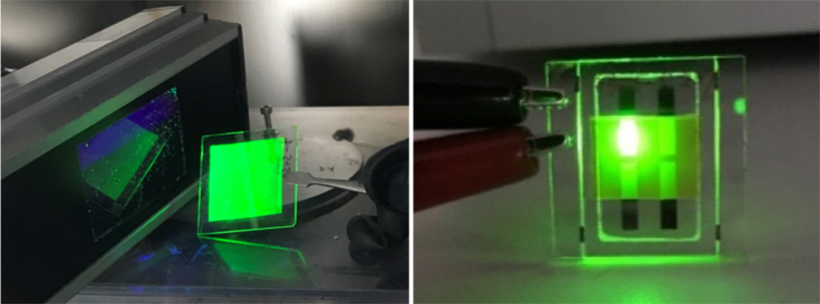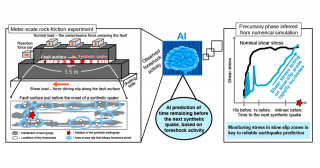Management of energetic excitons shown to be key for efficient light-emitting diodes with the low-cost materials
A collaborative team from Kyoto University and Kyushu University, has discovered the mechanism preventing efficient light emission from a class of low-cost materials and devised a strategy to overcome it, demonstrating highly efficient emission of green light from devices using the materials.
Called quasi-2D perovskites, the light emitters are extremely attractive for electronics applications because they can be easily produced from cheap starting materials using simple processes to achieve a wide range of electrical and optical properties, making light-emitting diodes (LEDs) based on perovskites highly promising for next-generation lighting and displays.
The studied perovskite emitters are a mixture of organic molecules and inorganic parts that organize to form a distinct crystal structure termed perovskite. Three-dimensional perovskites consist of organic and inorganic components that alternate in every direction, while the components form alternating sheets in two-dimensional perovskites. Quasi-2D perovskites are a combination of the two, with regions of 3D perovskite sandwiched between organic sheets.
Despite advances in perovskite LEDs, the reason for vast differences in efficiency for green emission in devices using different organic components had not been understood, but Kanemitsu Yoshihiko of the Institute for Chemical Research, along with researchers from Kyushu University and Changchun Institute of Applied Chemistry, say they now have the answer in a paper published recently in Nature Photonics .
“While many people have been treating perovskites like traditional inorganic semiconductors, we proved that quasi-2D perovskites are in many ways like organic semiconductors in that different forms of energy in excitons must be considered,” explains Chuanjiang Qin, first author on the study.
Unlike in typical inorganic semiconductors, electrical charges in organics combine to form an energetic state called an exciton before emitting light. Differences in a characteristic of the charges called spin leads to the formation of two types of excitons, singlets and triplets, with slightly different properties.
While the management of singlet and triplet excitons is fundamental to the design of efficient organic LEDs, similar considerations had not been discussed in perovskite LEDs. However, by comparing two perovskites with similar crystalline properties but different organic components, the researchers found that energy in triplets was being lost.
When the perovskite contained organics that would hold triplets in a low energy state, light emission was poor because triplet excitons—which generally want to move in the direction of lower energy—would transfer to the organic and be lost. Changing to an organic with a higher triplet energy lead to the triplets staying in the light-emitting component instead of transferring to the organics.
Additionally, the researchers demonstrated that, in quasi-2D perovskites with an appropriate organic component, the triplets, which do not emit light, could convert into light-emitting singlets, meaning that harvesting all of the electrically generated excitons may be possible.
Putting these findings to use and choosing the proper organic components, the team fabricated quasi-2D-perovskite LEDs that could efficiently harvest triplet excitons, achieving green emission with an external quantum efficiency—the percentage of electrical charges converted into external photons—of 12.4%.
“Not only can we finally explain previously observed results, but these new findings will offer insight and guidance for the development of future high-performance opto-electronic perovskite devices, such as LEDs, lasers, and solar cells.” says Chihaya Adachi, who led the research effort.

A low-cost and solution-processed perovskite film shows bright green emission under UV lamp excitation (left). A test perovskite light-emitting diode utilizing both singlet and triplet excitons in quasi-2D perovskite emits green light (right). (Kyushu University/Adachi Lab)
Paper Information
【DOI】 https://doi.org/10.1038/s41566-019-0545-9
Chuanjiang Qin, Toshinori Matsushima, William J. Potscavage Jr, Atula S. D. Sandanayaka, Matthew R. Leyden, Fatima Bencheikh, Kenichi Goushi, Fabrice Mathevet, Benoît Heinrich, Go Yumoto, Yoshihiko Kanemitsu and Chihaya Adachi (2020). Triplet management for efficient perovskite light-emitting diodes. Nature Photonics, 14(2), 70-75.





